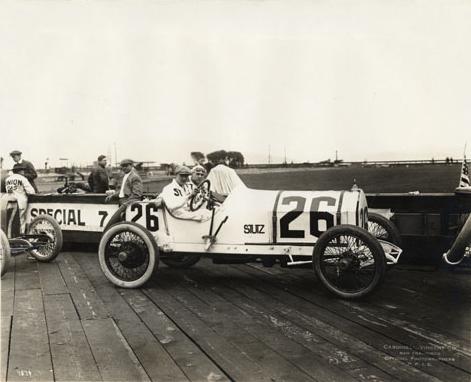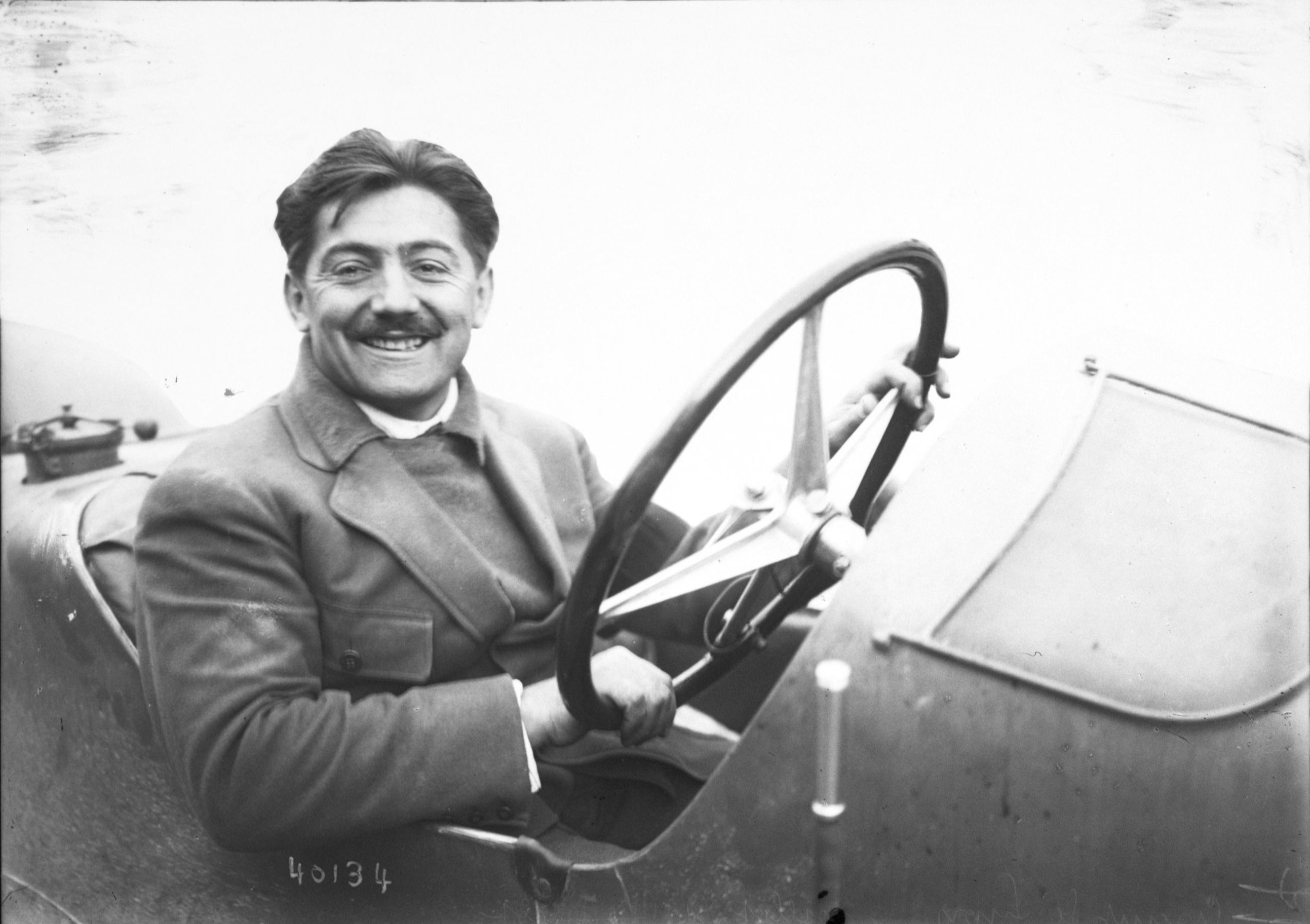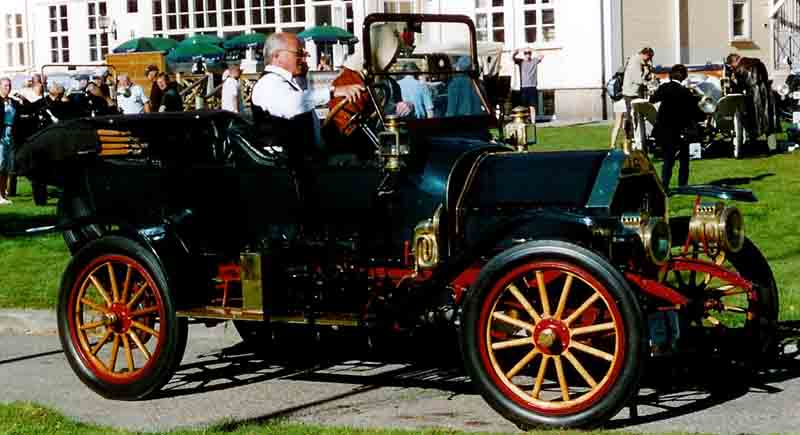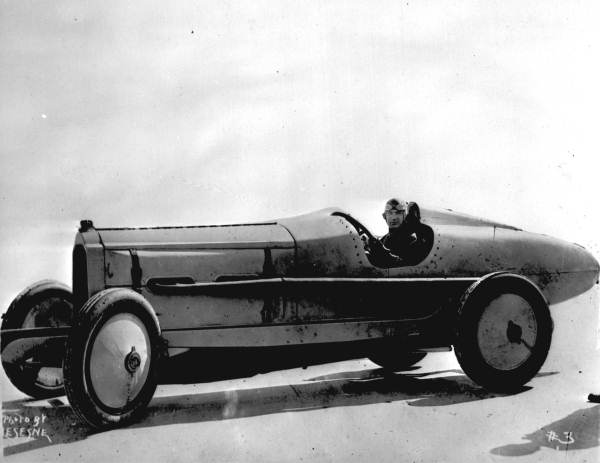|
1914 Indianapolis 500
The 4th International 500-Mile Sweepstakes Race was held at the Indianapolis Motor Speedway on Saturday, May 30, 1914. René Thomas was the race winner, accompanied by riding mechanic Robert Laly. Background Race history The Indianapolis Motor Speedway opened in 1909, and the first motorsport event at the track, a series of motorcycle races, was held in August of that year. A series of automobile races were held in 1909, but concerns were raised about the condition of the course after numerous accidents, including a fatality. The track was re-paved at a high-cost to Carl G. Fisher and the Indianapolis Motor Speedway Corporation, and further series of races took place in 1910. Fisher was worried about the dwindling attendances at these races, and decided to establish a 500-mile race; double the furthest distance of any previous race at the track. He went on to announce that the track would host no other races during the year, and that the prize for first place would be $2 ... [...More Info...] [...Related Items...] OR: [Wikipedia] [Google] [Baidu] |
AAA Contest Board
The AAA Contest Board was the motorsports arm of the American Automobile Association. The contest board sanctioned automobile races from 1904 until 1955, establishing American Championship car racing. Modern-day Indy car racing traces its roots directly to these AAA events. All of the races at the Indianapolis Motor Speedway during that time period were sanctioned by AAA, including the Indianapolis 500. AAA sanctioned the 1905 National Motor Car Championship, the first national championship for major auto racing. It resumed the National Championship in 1916, and again from 1920 to 1955. It also sanctioned the Vanderbilt Cup.White, GordonThe AAA Contest Board, Retrieved 2010-10-22 The AAA Contest Board dissolved and decided to focus strictly on helping the automobiling public as a result of the 1955 Le Mans disaster. History AAA was established in Chicago, Illinois on March 4, 1902. By June the same year, AAA also established the Racing Board. A. R. Pardington was appoint ... [...More Info...] [...Related Items...] OR: [Wikipedia] [Google] [Baidu] |
Car And Driver
''Car and Driver'' (''CD'' or ''C/D'') is an American automotive enthusiast magazine first published in 1955. In 2006 its total circulation was 1.23 million. It is owned by Hearst Magazines, who purchased it from its prior owner Hachette Filipacchi Media U.S. in 2011. It was founded as ''Sports Cars Illustrated.'' The magazine is based in Ann Arbor, Michigan. History ''Car and Driver'' was formed as ''Sports Cars Illustrated'' in 1955. In its early years, the magazine focused primarily on small, imported sports cars. In 1961, editor Karl Ludvigsen renamed the magazine ''Car and Driver'' to show a more general automotive focus. ''Car and Driver'' once featured Bruce McCall, Jean Shepherd, and Brock Yates as columnists, and P. J. O'Rourke as a frequent contributor. Former editors include William Jeanes and David E. Davis, Jr., the latter of whom led some employees to defect in 1985 to create ''Automobile''. When CBS acquired Ziff Davis' consumer magazines in 1985, ... [...More Info...] [...Related Items...] OR: [Wikipedia] [Google] [Baidu] |
Eddie Pullen
Edward Frank Pullen (August 16, 1883 — October 6, 1940) was an American racing driver who worked for and primarily raced the Mercer marque. Biography Pullen was born on August 16, 1883, in Trenton, New Jersey. Pullen began his racing career in 1912 and won his first Championship Car race on the road course at the Tacoma Speedway in Tacoma, Washington. He won the 1914 American Grand Prize at Santa Monica, but failed to qualify for the Indianapolis 500 as the Mercer he drove was better suited to road course racing than the open expanses of the Indianapolis Motor Speedway. Pullen raced for West Coast Mercer dealer George R. Bentel in 1915 along with Barney Oldfield and Eddie Rickenbacker. Pullen continued driving a Mercer even after the manufacturer had ceased supporting its racing program. He switched to a Hudson in 1919 but struggled. In 1921 for his final season of racing he switched to a Duesenberg and won a 20 lap race on the Beverly Hills board oval. Later that yea ... [...More Info...] [...Related Items...] OR: [Wikipedia] [Google] [Baidu] |
Billy Carlson
William Henry Carlson (October 17, 1889 – July 5, 1915) was an American racing driver. He was killed in an AAA National Championship race at Tacoma Speedway. Biography Carlson began his career competing in races on the Pacific coast and was a comparative unknown before he started in the 500-mile classic at Indianapolis in 1914. He took ninth in the event and "immediately attained prominence on the gasoline circuit." Carlson was a member of the Maxwell team for two years in 1914 and 1915 after he was "discovered" by Ray Harroun, a Maxwell engineer. His most notable achievement after joining Maxwell was his world's non-stop record of 305 miles made at San Diego, California, in January 1915. He came in second to Barney Oldfield at Venice, California Venice is a neighborhood of the City of Los Angeles within the Westside region of Los Angeles County, California, United States. Venice was founded by Abbot Kinney in 1905 as a seaside resort town. It was an independent c ... [...More Info...] [...Related Items...] OR: [Wikipedia] [Google] [Baidu] |
Kerosene
Kerosene, or paraffin, is a combustibility, combustible hydrocarbon liquid which is derived from petroleum. It is widely used as a fuel in Aviation fuel, aviation as well as households. Its name derives from the Greek (''kērós'') meaning "wax"; it was registered as a trademark by Nova Scotian, Nova Scotia geologist and inventor Abraham Pineo Gesner, Abraham Gesner in 1854 before evolving into a generic trademark. It is sometimes spelled kerosine in scientific and industrial usage. Kerosene is widely used to power jet engines of aircraft (jet fuel), as well as some rocket engines in a highly refined form called RP-1. It is also commonly used as a cooking and lighting fuel, and for fire toys such as Poi (performance art)#Fire poi, poi. In parts of Asia, kerosene is sometimes used as fuel for small outboard motors or even motorcycles. World total kerosene consumption for all purposes is equivalent to about 5,500,000 barrels per day as of July 2023. The term "kerosene" is comm ... [...More Info...] [...Related Items...] OR: [Wikipedia] [Google] [Baidu] |
Gasoline
Gasoline ( North American English) or petrol ( Commonwealth English) is a petrochemical product characterized as a transparent, yellowish, and flammable liquid normally used as a fuel for spark-ignited internal combustion engines. When formulated as a fuel for engines, gasoline is chemically composed of organic compounds derived from the fractional distillation of petroleum and later chemically enhanced with gasoline additives. It is a high-volume profitable product produced in crude oil refineries. The ability of a particular gasoline blend to resist premature ignition (which causes knocking and reduces efficiency in reciprocating engines) is measured by its octane rating. Tetraethyl lead was once widely used to increase the octane rating but is not used in modern automotive gasoline due to the health hazard. Aviation, off-road motor vehicles, and racing car engines still use leaded gasolines. Other substances are frequently added to gasoline to improve chemical st ... [...More Info...] [...Related Items...] OR: [Wikipedia] [Google] [Baidu] |
Maxwell Automobile
Maxwell was an American automobile manufacturer which ran from 1904 to 1925. The present-day successor to the Maxwell company was Chrysler, now Stellantis North America, which acquired the company in 1925. History Maxwell-Briscoe Company Maxwell automobile production began under the "Maxwell-Briscoe Company" of North Tarrytown, New York. The company was named after founder Jonathan Dixon Maxwell, who earlier had worked for Oldsmobile, and his business partner, Benjamin Briscoe, an automobile industry pioneer and part owner of the Briscoe Brothers Metalworks. Briscoe was president of Maxwell-Briscoe at its height. In 1907, following a fire that destroyed the North Tarrytown, NY, factory, Maxwell-Briscoe opened a mammoth automobile factory at 1817 I Ave, New Castle, Indiana. The newspapers reported that the factory "will operate as a whole, like an integral machine, the raw material going in at one end of the plant and the finished cars out the other end." This factory continued ... [...More Info...] [...Related Items...] OR: [Wikipedia] [Google] [Baidu] |
Teddy Tetzlaff
Theodore Herbert Tetzlaff (February 5, 1883 – December 8, 1929) was an American racing driver active in the formative years of auto racing. He competed in the first four Indianapolis 500s, with a highest finish of second in 1912 Indianapolis 500, 1912. He earned the nickname "Terrible Teddy" due to his rough treatment of his vehicles. His wide-open throttle racing style would variously win a race, blow up his engine or cause him to crash. As auto racing strategies evolved from the early "go as fast as you can and see if you can stay on the track," Tetzlaff's success in the sport waned. Biography Tetzlaff was born in Orange, California, on February 5, 1883. Speed records On March 19, 1911, as Lozier ads claimed, a stock model piloted by Tetzlaff set a world record for at 1:14:29. In 1914 the Moross Amusement Company of Ernest Moross engaged Tetzlaff to campaign the Benz, naming it "Blitzen Benz 2." He broke the world land speed record mark by running on the Bonnevill ... [...More Info...] [...Related Items...] OR: [Wikipedia] [Google] [Baidu] |
Ralph DePalma
Raffaele "Ralph" DePalma (occasionally spelt De Palma, December 19, 1882 – March 31, 1956) was an American racing driver who won the 1915 Indianapolis 500. His entry at the International Motorsports Hall of Fame estimates that he won about 2,000 races. DePalma won the 1908, 1909, 1910, and 1911 American AAA national dirt track championships and is credited with winning 25 American Championship Car Racing, American Championship car races. He won the Canadian national championship in 1929. DePalma estimated that he had earned $1.5 million by 1934 after racing for 27 years. He is inducted in numerous halls of fame. He competed on board track racing, boards and dirt track racing, dirt road courses and ovals. Biography Born in Biccari, Apulia, Kingdom of Italy, Italy, DePalma's family, who was from nearby Troia, Apulia, Troia, emigrated to the United States in 1891. When he arrived in the US he was told that, because his father had become a naturalized US citizen, he was automati ... [...More Info...] [...Related Items...] OR: [Wikipedia] [Google] [Baidu] |
Howdy Wilcox
Howard Samuel "Howdy" Wilcox (June 24, 1889 – September 4, 1923) was an American racing driver active in the formative years of auto racing. He won the 1919 Indianapolis 500. Formative years and family Wilcox was born in Crawfordsville, Indiana, on June 24, 1889. He was preceded in death by his wife, who died in 1918. Wilcox's son, Howard Jr., founded the Little 500 bicycle race, which has been held at Indiana University annually since 1951. Flanner and Buchanan Funeral Centers. Racing career  In 1911, Wilcox s ...
In 1911, Wilcox s ...
[...More Info...] [...Related Items...] OR: [Wikipedia] [Google] [Baidu] |
Caleb Bragg
Caleb Smith Bragg (November 23, 1885 – October 24, 1943) was an American racing driver, speedboat racer, aviation pioneer, and automotive inventor. He participated in the 1911, 1913 and 1914 Indianapolis 500. In speedboat racing, Caleb won three consecutive APBA Challenge Cup races in Detroit from 1923 to 1925. He was a co-inventor of the Bragg-Kliesrath brake. Early life Bragg was born on November 23, 1885, in Cincinnati, Ohio, to Cais C. Bragg and Eugenia Hofer who were wealthy. Education While at Yale University, Bragg became interested in automobile racing. Bragg graduated from Yale in 1908 and took a post-graduate engineering course at Massachusetts Institute of Technology in 1909. Racing career On October 5, 1912, Bragg driving a 14 liter F.I.A.T. S74 took 1st place at the 1912 American Grand Prize race, the seventh and final race of the 1912 Grand Prix season. It was held at the Wauwatosa Road Race Course near Milwaukee, Wisconsin and was sanctioned by the A ... [...More Info...] [...Related Items...] OR: [Wikipedia] [Google] [Baidu] |
Georges Boillot At The 1914 French Grand Prix
Georges may refer to: Places *Georges River, New South Wales, Australia *Georges Quay (Dublin) *Georges Township, Fayette County, Pennsylvania Other uses *Georges (name) * ''Georges'' (novel), a novel by Alexandre Dumas * "Georges" (song), a 1977 song originally recorded by Pat Simon and covered by Sylvie Vartan *Georges (store), a department store in Melbourne, Australia from 1880 to 1995 * Georges (''Green Card'' character) People with the surname *Eugenia Georges, American anthropologist *Karl Ernst Georges (1806–1895), German classical philologist and lexicographer, known for his edition of Latin-German dictionaries. *Mary Ngwanda Georges, Congo-born American politician See also *École secondaire Georges-P.-Vanier, a high school in Hamilton, Ontario, Canada *École secondaire Georges-Vanier in Laval, Quebec, Canada * French cruiser ''Georges Leygues'', commissioned in 1937 * French frigate ''Georges Leygues'' (D640), commissioned in 1979 *Georges Krayem, Brazilian lawyer * ... [...More Info...] [...Related Items...] OR: [Wikipedia] [Google] [Baidu] |





